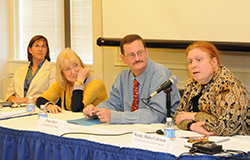
College marks 50th anniversary of Rachel Carson's 'Silent Spring'

To commemorate the 50th anniversary of the publication of Rachel Carson's "Silent Spring," Connecticut College hosted a symposium on Oct. 18 to celebrate the landmark work credited with creating the environmental movement. "Five Decades after Silent Spring" included a panel discussion reflecting on Carson's legacy.
The panel was chaired by Linda Lear '62, author of the award-winning biography "Rachel Carson: Witness for Nature." A recipient of the Goodwin-Niering Center for the Environment Alumni Achievement Award, Lear serves on the Advisory Board of the center and is a former trustee of the College. In 1998, she donated her research archives to the College to establish the Lear-Carson Collection. In 2008, the Linda Lear Center for Special Collections & Archives opened in Shain Library to preserve and promote the College's most precious resources for learning and research.
The event began with a panel discussion reflecting on Rachel Carson and her legacy. Panelists included Naomi Oreskes, professor of history and social science at the University of California, San Diego; Peter Siver, the Charles & Sarah P. Becker '27 Professor of Botany and director of the environmental studies program at Connecticut College; Helen Rozwadowski, associate professor of history, University of Connecticut; and Wendy Blake-Coleman, Office of Environmental Information, Environmental Protection Agency.
The discussion examined Carson's book and the response to her work by the federal government, the pesticide industry and the public. The book has been credited with launching a national discussion on the widespread use of DDT.
"For me, 'Silent Spring' goes deeper than DDT in terms of what she knew and what she taught us about pesticides," said Siver. "My take home is that when we look at these chemicals and classify them, we need to start looking at them in their formulations and how the chemicals collectively have an impact."
Rozwadowski urged those in attendance to consider the other, less-publicized environmental facets of Carson's research, such as the treatment of oceans; while Blake-Coleman addressed the increasing role of the general public in environmental advocacy. "Public participation is the key to shaping many environmental decisions," she said.
The series concluded with a lecture, "The Fracking of Rachel Carson: Silent Spring in an Age of Environmental Crisis," by environmental advocate Sandra Steingraber. A cancer survivor, Steingraber has written extensively on the intersection of the environment and public health.
A special exhibit, "Rachel Carson's Silent Spring: Rumblings of an Avalanche," was on display in Shain Library throughout October.
"Five Decades after Silent Spring" was supported by the Sound Lab Foundation, the Friends of the Connecticut College Library, Connecticut College Information Services, the Lear Center for Special Collections & Archives, the Goodwin-Niering Center for the Environment and Linda Lear.
- Laura Cianciolo '16 contributed to this article.
November 14, 2012
